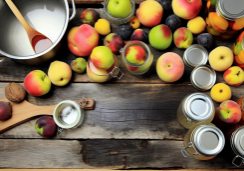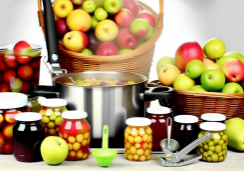Seasonal Fruit Preservation: Your Easy Canning Guide
You might not be aware that the art of canning fruit dates back to the late 18th century, a time when preserving food was as critical for survival as it was a culinary experiment. As you stand in your kitchen, surrounded by the vibrant bounty of seasonal produce, consider the legacy you're partaking in—a tradition that has been refined over centuries.
You're about to embark on a journey that will not only allow you to savor the flavors of summer during the chill of winter but will also equip you with skills to reduce waste and enhance your self-sufficiency. In the following sections, you'll discover the secrets to selecting the right fruits and the nuances of different preservation techniques, from water baths to pressure canning.
But before you start washing those mason jars, let's first understand why some fruits make better candidates for canning than others and how this knowledge can transform your preservation efforts from good to exceptional.
Selecting Suitable Fruits
When selecting fruits for canning, opt for ripe, unblemished specimens to ensure the highest quality in your preserved treats. Seasonal fruit preservation not only maximizes the taste and freshness but also allows you to enjoy summer fruits year-round.
To preserve fruits effectively, you'll need to understand the canning method that suits your chosen produce. High-acid foods like berries and tomatoes are perfect for water bath canning, a simple technique that uses boiling water to seal jars. For low-acid fruits, a pressure canner is essential to ensure safe preservation.
As you prepare your jars, remember that each fruit has its unique requirements. For instance, adding lemon juice to prevent browning is crucial for apples and pears. It's not just about preventing discoloration; the lemon juice also helps preserve the fruit's natural flavor.
To achieve the best results, always adhere to the recommended headspace—the gap between the surface of the food and the jar's lid. This space is vital for creating a vacuum seal during the canning process.
Whether you're making jam, jelly, or whole fruit preserves, the right preparation will ensure your seasonal delights are safely stored for future enjoyment.
Preparing Your Equipment
Before diving into the canning process, make sure your jars, lids, and bands are clean and free of defects to ensure a safe and successful preservation.
You'll need a deep pot—either a boiling water bath canner for high-acid fruits or a pressure canner for low-acid varieties. For a water bath, use a pot with a rack to keep jars from touching the bottom, and have enough water to cover them by at least 2 inches.
Start by washing the jars and lids in hot, soapy water. Rinse them well and then sterilize the jars by boiling them in the canner for 10 minutes. Meanwhile, keep the lids and bands warm—not boiling—to soften the sealant. Always be sure to follow the manufacturer's instructions.
When it's time to fill the jars, use a funnel to keep the rims clean. Remove air bubbles by running a non-metallic spatula inside the jar. Check the headspace, and add more fruit or syrup if necessary. Wipe the rim with a clean cloth, place the lid to check for a proper seal, and then screw bands on until fingertip-tight.
Water Bath Canning Method
Having prepared your equipment and ensured everything is sterilized, you'll now focus on the water bath canning method, a straightforward technique ideal for preserving high-acid foods such as fruits and pickles. Begin by filling your canner with enough water to cover your jars by at least one inch and bring it to a simmer. Meanwhile, prepare your acidic foods following a reliable recipe.
Once your fruits or pickles are ready, fill jars with the hot mixture, maintaining the correct headspace as specified in your recipe. This space is crucial for creating a vacuum seal. Remove any trapped air bubbles by running a non-metallic utensil around the inside of the jar. Wipe the jar rim to ensure a clean sealing surface, then place flat lids and screw bands on, adjusting to fingertip-tight.
Carefully lower hot jars into the canner with boiling water using a jar lifter. The water should cover the jars completely. Process them for the time specified in your recipe, adjusting for altitude if necessary. Once done, turn off the heat, remove the canner lid, and let jars sit for 5 minutes before removing them.
Allow the jars to cool undisturbed for 12-24 hours. Check seals, label, and store your preserved fruits or pickles for later enjoyment.
Pressure Canning Technique
To ensure your low-acid foods are safely preserved, turn to pressure canning, a method that utilizes high temperatures achieved through steam pressure to eliminate harmful bacteria. This technique is indispensable for foods like meats, green beans, and other vegetables that don't have the high acidity required for water bath canning. Using a pressure canner allows you to reach the high heat necessary to kill off any potential contaminants.
When you start the canning process, make sure to follow the time indicated by reliable sources such as the National Center for Home Food Preservation. This will ensure safe preservation. Unlike high-acid foods, which can be processed using the simpler water bath method, low-acid foods require the extra oomph that only a pressure canner can provide.
It's critical that you adhere to the precise processing times and maintain the pressure specified by the recipe. Insufficient processing could result in foodborne illness, while overprocessing may compromise the quality of your preserved goods.
Once the time is up, turn off the heat and let the pressure return to normal before opening the canner. Check that your jars are properly sealed before storing them. Mastering the pressure canning technique means you'll enjoy your harvest all year round, safely and deliciously.
Storing and Labeling Jars
Once your jars have cooled completely after canning, it's time to label them with the contents, preservation date, and any other pertinent details. Ensure the canning lids have sealed properly; the lid shouldn't flex up and down when the center is pressed. Remove the bands used during the hot water bath canning or pressure canning methods, and wipe the rim of the jar to remove any residue.
Use waterproof, smudge-proof labels to clearly mark each jar with the contents and date. It's essential to use labels that adhere well and remain legible over time. Place the labels on the side of the canning jars, ensuring they don't cover the lid in place, so you can easily inspect the seals periodically.
When storing your jars, opt for a cool, dark place. This environment helps maintain the quality and longevity of your preserves. Avoid places with direct sunlight or fluctuating temperatures, which can compromise the seal and food quality.
Frequently Asked Questions
What Fruits Are Seasonal for Canning?
You'll find fruits like strawberries and blueberries in summer, pears and apples in fall, and citrus in winter. Their ripening times, unique flavors, and nutritional benefits make them perfect for canning.
How Do You Preserve Seasonal Fruit?
You can preserve seasonal fruit by freezing, drying, making jams, pickling, using sugar syrups, vacuum sealing, infusing with alcohol, crafting fruit leathers, creating herbal preserves, or salt curing for long-lasting, delicious flavors.
What Is the Easiest Fruit to Can?
You'll find peach simplicity and berry basics ideal for easy canning. Start with these, then explore apple abundance, pear procedures, and grape guidelines for a variety of delicious, home-preserved treats.
What Is the Easiest Way to Preserve Fruit?
You can easily preserve fruit by freezing methods, using airtight containers, or making fruit jams. Pickling fruits and fruit dehydration are also simple. For longer storage, try vacuum sealing or alcohol preservation.
Conclusion
Now that you've mastered seasonal fruit preservation, you're set to savor the flavors year-round. Remember, choose fresh, unblemished fruits, prep your gear, and decide between water bath or pressure canning based on acidity.
Store your bounty in a cool, dark place and label each jar with the contents and date. With these practical skills, you'll reduce waste and enjoy homemade delights whenever you wish.
Happy canning!










